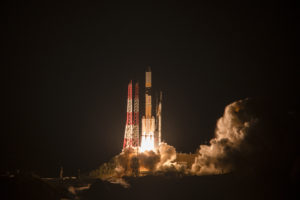- I-6 F1 first of seven new Inmarsat satellites to be launched by 2024 in fully-funded technology roadmap.
- Launched by Mitsubishi Heavy Industries from Japan at 15:32 UK time on 22 December 2021.
- Most sophisticated commercial communications satellite ever begins journey to geostationary orbit.
- I-6 F1 to deliver enhanced ELERA (L-band) and Global Xpress (Ka-band) for Indo-Pacific.
23 December 2021 – Inmarsat, the world leader in global, mobile satellite communications confirms the successful launch of its first Inmarsat-6 satellite, I-6 F1, by Mitsubishi Heavy Industries (MHI) from the JAXA Tanegashima Space Center in Japan.

Inmarsat-6s (I-6) are Inmarsat’s first ever hybrid L- and Ka-band satellites, incorporating increased capacity and new technological advances for ELERA’s transformational L-band services alongside additional Global Xpress (GX) high-speed broadband capacity. Adding to an existing global fleet of 14 geostationary satellites they extend Inmarsat’s commitment to mission critical services while enabling a new generation of pioneering technologies to connect and sustain the world. This launch is the first of seven planned for Inmarsat by 2024 in the company’s fully-funded technology roadmap.
Launch success was confirmed by MHI at 15:59 UK time on 22 December following satellite separation from the H-IIA launch vehicle, with successful signal acquisition soon afterwards.
The most sophisticated commercial communications satellite ever launched, I-6 F1 is comparable in size to a London double-decker bus, with a deployed solar arrays ‘wingspan’ similar to a Boeing 767 and a 9 metre wide L-band reflector that will be deployed over the coming days. The satellite will then be raised to geostationary orbit (GEO) approximately 36,000km (~22,500 miles) above the Earth via its all-electric propulsion system and then undergo a thorough and extensive testing programme. I-6 F1 will enter service in 2023. Ground stations in Western Australia will support I-6 F1.
Rajeev Suri, CEO of Inmarsat, said “This launch marks Inmarsat’s newest technological leap forward as we maintain our strong commercial momentum and sector leadership. It gives me great pleasure and pride to confirm the successful launch of I-6 F1. This satellite extends our world leading mobile satellite communications services for our customers and partners, especially in the Indo Pacific region. My warmest thanks and congratulations go to the Inmarsat team that delivered flawlessly on this project as well as our launch provider Mitsubishi Heavy Industries and our satellite manufacturing partner Airbus Defence and Space.”
The I-6 satellites demonstrate Inmarsat’s ongoing investment and commitment to its global leadership in L-band satellite services to 2040 and beyond for the benefit of mobility customers worldwide. They deliver an enhanced platform for those looking to embrace the next wave of world-changing technologies that ELERA enables, including the rapidly growing Industrial Internet of Things (Industrial IoT) satellite connectivity market segment, by providing dramatically increased network capacity and resilience.
These new capabilities from the I-6s mean greater capacity and coverage, greater speeds and a greater portfolio of innovative connectivity solutions for ELERA and Global Xpress (GX) networks. The I-6 satellites, like all Inmarsat ELERA and GX spacecraft, are backward-compatible with existing terminals, ensuring that current and future customers will continue to benefit from new advances.
The I-6s also substantially increase the effective capacity of the network available to ELERA customers with double the beams, 50% more spectrum per beam and double the power of the I-4s, matching customer demand as and where it is needed. They also add further depth in Inmarsat’s global coverage for even greater assurance to customers of the redundancy and resilience of Inmarsat’s world-leading L-band network.
The GX6 payloads hosted on the I-6s add targeted high capacity to Inmarsat’s high-speed GX network, ensuring it continues to support the growing need of commercial and government customers for data, particularly in congested regions or hotspots where it is needed most.
The launch of the I-6s is further evidence of the momentum underpinning Inmarsat’s business and technology leadership in global mobility communications. I-6 plays an integral role in the reliable GEO infrastructure that underpins Inmarsat ORCHESTRA – the world’s first network that will combine GEO, highly elliptical orbit (HEO), low Earth orbit (LEO) and terrestrial 5G into one harmonious solution.
About Inmarsat
Inmarsat is the world leader in global, mobile satellite communications. It owns and operates the world’s most diverse global portfolio of mobile telecommunications satellite networks, and holds a multi-layered, global spectrum portfolio, covering L-band, Ka-band and S-band, enabling unparalleled breadth and diversity in the solutions it provides. Inmarsat’s long-established global distribution network includes not only the world’s leading channel partners but also its own strong direct retail capabilities, enabling end to end customer service assurance.
The company has an unrivalled track record of operating the world’s most reliable global mobile satellite telecommunications networks, sustaining business and mission critical safety & operational applications for more than 40 years. It is also a major driving force behind technological innovation in mobile satellite communications, sustaining its leadership through a substantial investment and a powerful network of technology and manufacturing partners.
Inmarsat operates across a diversified portfolio of sectors with the financial resources to fund its business strategy and holds leading positions in the Maritime, Government, Aviation and Enterprise satcoms markets, operating consistently as a trusted, responsive and high-quality partner to its customers across the globe.
